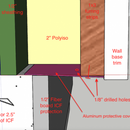Bottom edge detail – rigid foam next to sill plate
I’ve read through most of the previous posts regarding protecting the bottom edge of exterior insulation from rodents / insects. It seems the perforated U-shaped channel is typically preferred, though can be challenging/expensive to source in certain areas.
I’m building a small DIY addition with 2″ polyiso on the exterior, zone 6A. The edge of my ICF stem wall extends beyond the sheathing by 1/2″. I’m looking to come up with a better, less expensive option for protecting the polyiso at the base:
Concept/Process:
*Install Polyiso, tight to the ICF EPS at bottom
*Install 1×3 rain screen furring, extending slightly below Polyiso (~1/8″)
*Install all other wall cladding/details, water table trim 1/8 below furring
*Install Aluminum flat sheet, 16ga as shown in pic (1/8″ holes predrilled) (no bug screen planned at this point). Wedge between ICF foam and Polyiso and screwed to bottom of furring strips.
*Install ICF protective coverboard, with upward pressure when attaching to ensure there are no gaps between Aluminum and ICF coverboard.
What this does:
*simple, well protected, low-cost
*no special bending / or difficult to source materials
*avoid Cora-vent cost / installation
*protect bottom of foam and furring from rain backsplash (close to grade)
*easy to install / inspect
*not integrated / easy to replace
I’m thinking this would work well as long as I put enough holes in the aluminum.
Thoughts?
GBA Detail Library
A collection of one thousand construction details organized by climate and house part










Replies
You can use stainless steel insect screen mesh rolls, usually 36"-60" wide. Cut it to 6"-12" wide rolls. Staple the screen to the wall sheathing, wrapping the screen under the rigid foam and the 1x3s, and then staple it secured. Finally, install the base trim on top. You want to form a "U" shape screen.
Thanks Armando. Do you find that the stainless mesh is also adequate for critters? Any particular grade / wire size / opening size that you would recommend? Maybe I'll go with the mesh and then pre-plan for a future critter plate if it's ever needed.
steve41,
Builders here moved way from using insect screen in favour of perforated flashing because it was so susceptible to mechanical damage (pests and vegetation growing up into the cavity and being pulled out), and it being very difficult to repair or replace.
Thanks Malcolm. In lieu of a perforated U-shaped flashing, would the flat aluminum concept shown in my original post work well? I would simply pop in a series of 1/8" holes, maybe 2 rows, 4" OC in the furring area. Seems like it would be easy, inexpensive, and effective... but this is new to me.
steve41,
As long as you are happy to drill the holes, I don't see much downside to your detail. The more holes the better.
A question for you. I am doing something similar but have not figured out what i am using to protect my icf foundation (was going to potentially get parging or stucco done). But am curious what you are using (the fiber board) is it like the fiber cement board some would use in a shower install? Thanks in advance.
nrosdal,
Originally I was planning to use aluminum coil stock for the exterior ICF protection, and I still may. Aluminum looks like an easy DIY option, I'm just a little concerned about its longer term appearance with the inevitable dings and dents.
I have started to look into fiber cement panels more recently. I have only found one source that manufactures a product rated for below grade: http://gofinex.com/en/fiber_cement_panels_finex.php
This video sparked my interest in the fiber board: https://www.youtube.com/watch?v=likwXoBpJTo&list=WL&index=1
Currently the Finex product is only available in Canada so I'm still exploring options.
Boral TruExterior is rated for ground contact. I'm considering using this to protect foam insulation below the siding, and would be interested in any opinions on using it for that.